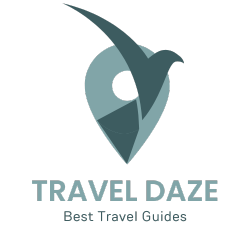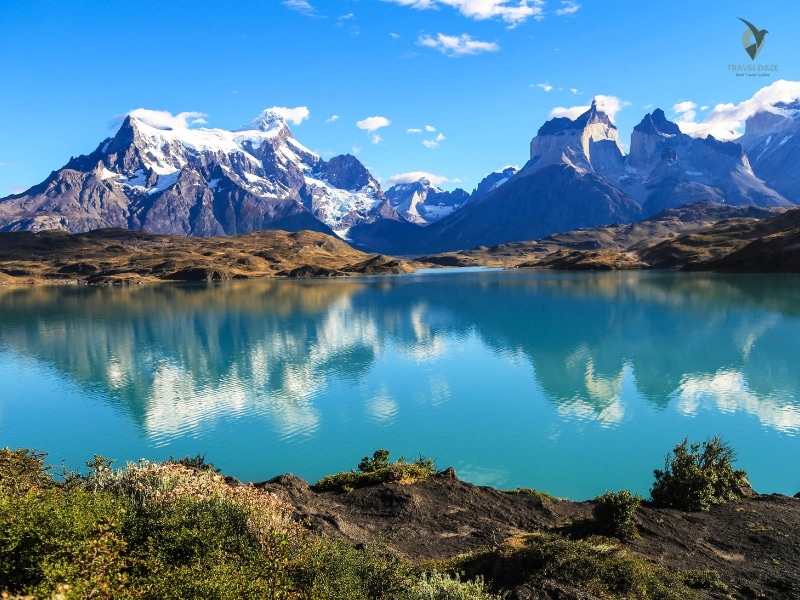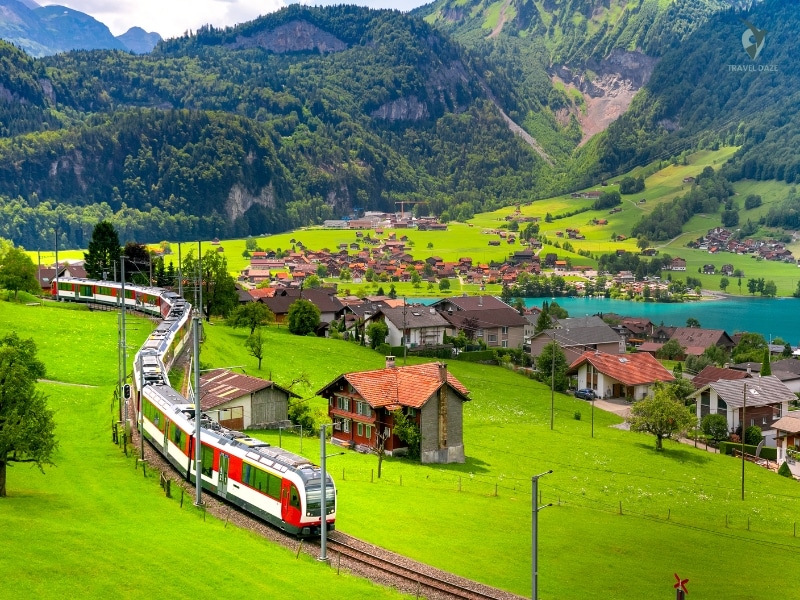Are you imagining large glaciers, rough terrains, and amazing hikes? I felt the same way—until I spent six months exploring Patagonia on my own adventure. This wild area, spanning Chile and Argentina, requires careful planning but offers unforgettable experiences in return.
Table of Contents
ToggleI faced challenges like border crossings and unpredictable weather, and I learnt through experience. Don’t worry—I’ll share my top tips for creating the perfect itinerary, whether you have two weeks or two months. You will learn how to mix popular attractions with lesser-known treasures while keeping your expenses low.
Main Points
- Patagonia covers two countries, so it’s important to plan your route carefully.
- Self-planning is possible with the right tools.
- Summer, from December to February, has the best weather, but it also brings larger crowds.
- Combine famous hikes with hidden trails for a well-rounded adventure.
- There are affordable choices available, even in distant locations.
Reasons to Choose Patagonia for Your Next Adventure
This place combines untouched nature with stunning beauty like nowhere else on Earth. High granite mountains, wide ice fields, and open plains form a scene that seems unspoiled. This is a place that stays in your mind even after you go.

What Makes This Place Unique?
The variety here is amazing. One day, you hike by bright blue glaciers, and the next, you see condors flying around sharp cliffs. In contrast to busy tourist spots, the wide open spaces allow you to enjoy trails without the crowds.
Geology is very important. Chile’s landscape shines with the famous Torres del Paine—three granite towers reaching up into the sky. Argentina features the sharp peaks of Fitz Roy and the impressive Perito Moreno Glacier. Both sides perform well, but they do it in very different manners.
Chile and Argentina: Choosing Your Base
Deciding between these two countries depends on what you feel like. Chile’s parks have clear signs and mountain huts for a comfortable trekking experience. Argentina. Imagine a natural, untouched landscape where camping in the wild is the way to go.
I liked the quieter trails in Argentina. Chile’s W-Trek was lively and crowded, while the trails in El Chaltén provided a sense of peace and quiet. Wildlife varies as well—guanacos wander the steppes of Argentina, while condors soar in the skies of Chile.
- In terms of budget, Argentina usually has lower prices for food and accommodation.
- Border logistics are easier when you concentrate on a single country.
- In Chile’s tourist areas, language barriers disappear, but they remain in remote parts of Argentina.
My moment of realisation? Watching the sunrise at Laguna de los Tres—no crowds, just the reflection of Fitz Roy in the glacial water. That’s the beauty of choosing the right side for your style.
The Ideal Time to Visit Patagonia for Great Weather
The weather changes quickly here, so make sure to plan ahead. I arrived in March 2024, looking forward to pleasant autumn days. Instead, I experienced 55°F sunshine at noon and 35°F frost by dusk. Be prepared for all four seasons, even during summer.
Summer Crowds or Quiet Times in the Shoulder Season
From December to February, we experience long days and strong winds. Trails are lively with hikers, but the refugios fill up quickly. Here’s my helpful tip. Target late February. You’ll avoid the biggest crowds while still finding available huts.
March to April was my favourite time. Less crowded, beautiful golden leaves, and fresh, cool air. What are the drawbacks? Some hotels shut down by mid-April, and the coastal weather becomes unpredictable. I saved 30% on accommodation compared to the busy season.
Breakdown by Month
- In December and January, expect daytime temperatures around 60°F and nights around 40°F at Perito Moreno Glacier. Bring windproof layers—winds can reach 50mph.
- In February, temperatures range from 50 to 58°F. There are fewer rainy days, making it a great time for photography.
- In March, temperatures range from 40 to 55°F. The fall colours are at their best, so be sure to bring thermal leggings.
- In April, temperatures range from 35 to 50 degrees Fahrenheit. The trails are quiet, but be sure to check for any closures.
Microclimates are fascinating. One morning close to El Calafate, I took off my shirt and wore just a t-shirt. In the afternoon, hail hit my rain jacket. Always have with you:
- Base layers made from Merino wool
- A shell that is waterproof
- Gloves and a beanie, even during summer.
Visit in April for some peace and quiet. For dependable weather, pick February. Be careful not to trust forecasts too much—this land has its own way of doing things.
Ways to Reach Patagonia Calmly
Getting to this remote area takes careful planning—here’s how I managed it. Planning ahead helps avoid problems, whether you’re flying into Chile or Argentina. I will explain flights, border logistics, and shuttle tips.
Air Travel: Entry Points and Advice
Sky Airlines provides the most affordable route. I paid $107 for my flight from Santiago (SCL) to Puerto Natales (PNT). It’s a good idea to book early for better prices. LATAM is more expensive, but it includes checked bags. Here’s a helpful tip: Pack lightly to steer clear of extra charges.
When you arrive, shared shuttles to the town range from 4,000 to 8,000 CLP (around $5 to $10). Drivers only take cash, so make sure to withdraw pesos in advance. I bought my bus tickets from BusBud.com. It was straightforward, and I received instant confirmations without any issues.
- Other airport options include El Calafate in Argentina or Ushuaia for Antarctic cruises.
- For days when you need to use different types of transport, it’s best to use a backpack. Wheeled bags can have a hard time on gravel roads.
Crossing the border between Chile and Argentina
Border rules are different. Holders of U.S. passports do not require a visa, but officials carefully examine the stamps. One time, my friend’s smudged stamp led to a 2-hour delay—make sure to check yours right away!
Buses such as Bus-Sur operate every day, but the routes become limited during winter (May–Sept). Always check schedules in your area. Emergency contacts helped me when a driver didn’t show up:
- Chilean Tourist Police: +56 2 922 0816
- Argentine Consulate in Puerto Natales: +56 61 241 3308
To have more freedom, rent a car in Buenos Aires and head south. Be aware that petrol stations can disappear quickly in the more remote areas of South America.
Travelling Through Patagonia Like an Expert
Using public transport here is more than just getting from one place to another; it’s an exciting experience. With rough roads and tight schedules, having a plan is essential. I will explain the best ways to save time and reduce stress.

Buses: Timetables and Booking Tips
Buses are essential for transportation. Bus-Sur and Turibus operate daily routes, but their schedules change with the seasons. Every day, four buses depart from Puerto Natales to Torres del Paine between 7:30 AM and 2:30 PM, costing $13.
Here’s a helpful tip: Check out BusBud.com to compare different routes. Tickets display departure times in military format—14:30 means 2:30 PM.
- Puerto Natales Terminal: Situated at Av. España 1455; please arrive 30 minutes early.
- Buses such as Cootra make stops for passport checks, so be sure to bring some snacks.
- Hitchhiking is an option, but it comes with risks. I only accepted rides from strangers during the day.
Car Rentals or Guided Tours
Do you desire freedom? Rental cars are about $50 per day at Magallanes Rent A Car. However, roads can challenge your patience.
- On gravel routes, tyre punctures happen often, so it’s a good idea to get full insurance.
- Petrol stations: Refuel in towns; there are some areas without any for hours.
Guided tours make planning easier, but they are three times more expensive. DIY hikes allow you to discover at your own speed. I’m choosing. Combine both options: book a tour for Fitz Roy and rent a car for scenic coastal drives.
Accommodation Options in Patagonia for All Budgets
The right place to stay can greatly affect your experience in this rugged area. No matter if you like backpacking or enjoy more comfort, there’s an ideal place for you. I’ve tried everything from hostels to remote refugios—here’s what works best.
Hostels and guesthouses
My favourite mid-range choice was Hostel El Patagonico, which costs $62 per night. The private rooms were heated, and the kitchen was well-stocked. Budget travellers can find dorms for $30 a night at Erratic Rock, but it’s best to book early since they fill up quickly.
Ecocamp Patagonia offers luxurious geodesic domes starting at $200 per night. It’s great for enjoying hot showers and looking at the stars through the windows. The noise levels are different: downtown Puerto Natales is busy and lively, while quieter places like Hostel Lago Grey are better for light sleepers.
Camping and Shelters in National Parks
Mountain huts cost between $45 and $64 per person. Make sure to book at least 3 months in advance for the central sector of Torres del Paine. Beds have thin mattresses, so it’s a good idea to bring a sleeping bag liner. Storage lockers are hard to find, so pack lightly.

Campsites offer two choices: you can either bring your own gear or rent it on-site. The latter costs $15 per night, but it often doesn’t have tents available. Here’s my helpful tip. Consider renting in town, like Rental Natales, for improved quality. Always check:
- Some remote sites do not have access to water.
- Durable shelters for cooking in any weather
- Closed for the season from April to October.
To unplug digitally, avoid hotels with a lot of Wi-Fi. Refugio Frances has no signal—only the sound of crackling fires and stories from the trail. Prices rise from December to February, while March provides the best value.
Essential Destinations in Chilean Patagonia
My first memory of Torres del Paine National Park is of granite towers reaching up into the sky. This UNESCO biosphere reserve features glaciers, turquoise lakes, and trails that will challenge your legs. Just south, Puerto Natales offers warm empanadas and rentals for gear you might need at the last minute.
Exploring the Crown Jewel: Torres del Paine
The W-Trek spans 5 days and covers 47 miles, offering great highlights that are manageable for beginners. My hiking journal records:
- Day 1: Mirador Las Torres viewpoint—get there by 5 AM to see the sunrise.
- On Day 3, the ice of Glacier Grey makes a crackling sound that resembles thunder.
Dedicated hikers choose the O-Trek, which takes 8 days and covers 75 miles. It includes the more rugged area at the back. Reserve your refugios at least 4 months in advance, particularly for Campamento Dickson.
Tips for spotting wildlife:
- Look for Andean condors on the cliffs at dawn.
- Pay attention to the alarm calls of guanacos near Laguna Azul.
Puerto Natales: Your Base for Adventure
This coastal town is full of exciting adventures. Rental Natales offers quality tents for $10 a day, and La Mesita Grande serves pizza that is as big as your backpack. Be sure to catch:
- The sunset at Costanera features pink skies above the Señoret Channel.
- Museum of History: Nautical artefacts and replicas of Kawéskar canoes
For great photos, visit Laguna Amarga during golden hour when the calm waters reflect the towers beautifully. Guides charge $147 or more for horseback rides, but you can take the 7 AM shuttle for just $15 to get there on your own.
Must-See Places in Argentine Patagonia
Argentina’s part of this wild area offers excitement—sharp peaks, breaking glaciers, and paths where pumas wander freely. Although Chilean parks receive a lot of attention, I found the natural beauty of Argentina to be even more impressive. Focus your time here.
El Chaltén and Mount Fitz Roy
This small mountain town is the hiking capital of Argentina. The trails of Fitz Roy are wonderfully peaceful, unlike the busy crowds at Torres del Paine. Los Glaciares National Park has no entry fees, which is quite unusual.
Here are the hikes I really want to do:
- Laguna de los Tres: A challenging 6-hour round trip to the base of Fitz Roy. Begin at 4 AM to avoid strong wind gusts.
- Loma del Pliegue Tumbado offers stunning views and has 90% fewer hikers compared to the main trails.
Camping for free near Río de las Vueltas helped me save $40 each night. Here’s a local tip: get your supplies at La Oveja grocery. Their empanadas are perfect for long hikes.
Perito Moreno Glacier
Seeing this massive glacier break off pieces into Lake Argentino took my breath away. Boat tours cost $100 and bring you close, while Bigfoot Patagonia’s ice hikes are $220 and allow you to walk on the glacier with crampons.
Equipment details:
- Durable waterproof boots (available for rent)
- Gloves keep the ice at 32°F all year long.
- Polarised sunglasses help cut down on glare.
Here’s an interesting fact: This glacier gets bigger every day, unlike most that are getting smaller. Rangers keep an eye on its balance—moving forward 6 feet while melting 6 feet keeps it the same size.
To find hidden views, avoid the boardwalks. Walk the western part of the Sendero Costa trail during sunset. I saw a puma here—keep a distance of over 50 feet and avoid running.
Exploring Patagonia: Unforgettable Trails
As I tied my boots for the first time on these famous trails, I soon understood why hikers speak so highly of this area. No matter if you are going on long treks or short hikes, every path has its own challenges and rewards. Here’s how to pick your adventure and enjoy it with a smile.
Should I choose the W-Trek or the O-Trek? Choosing Your Epic
The W-Trek is 47 miles long and takes 5 days, making it ideal for beginners. My pack weighed 22 lbs—light enough to prevent shoulder bruises but heavy enough to handle sudden hailstorms. Important stops:
- Mirador Las Torres: A 13-mile round trip with an elevation gain of 2,600 feet. Begin your day early to avoid the crowds.
- Refugio Grey: Wake up to the sound of glacier cracks resonating around Lago Grey. Reserve your beds four months in advance.
The O-Trek is a journey of 75 miles over 8 days, taking you through remote backcountry. I was sore for days after climbing Dickson Pass, but it was worth it for the beautiful, untouched valleys. Bring 30% more snacks; resupply points disappear after Day 3.
Hiking Trails for All Abilities
Not prepared for long hikes? These day hikes offer great views without the need for a heavy backpack:
- Laguna Torre is an 11-mile round trip. The trail is mostly flat and leads to a lake fed by a glacier.
- Cerro Castillo (8 miles): It’s steep, but you’ll be rewarded with views of condors. Poles assist on loose gravel.
To prevent blisters on your trip, wear liner socks under your wool socks and tape any hotspots before they break open. Trail apps such as Maps.me can be used without an internet connection—just download the maps while you’re in town. In Chile, routes are marked with orange markers, while in Argentina, they use red-and-white stripes.
Stream crossings can come up quickly. My close call? Slipping on an easy Río Paine crossing. Always unbuckle the waist strap of your pack. You’ll want to remove it quickly if you fall.
Essential Packing Tips for Patagonia
The weather here doesn’t care about ‘water-resistant’ labels—pack as if you’re getting ready for a storm. After testing equipment on 200 miles of trails, I’ve identified the must-haves. Eliminate the uncertainty with my proven list.
Learn the Layering System
Clothing is based on a 3-layer system: a moisture-wicking base layer, an insulating middle layer, and a waterproof outer layer. This is my exact setup:
- Two merino wool tops from Icebreaker.
- Mid: A packable down jacket (Patagonia Nano Puff)
- Shell: Gore-Tex rain jacket (Arc’teryx Beta LT)
Windproof gloves and a neck gaiter protected me during hail storms. Stay away from cotton, as it takes a long time to dry.
Reliable Gear You Can Count On
To go camping, you can rent a 4-season tent for $12 a day at Rental Natales. Their gear lists feature stakes that stay strong in strong winds. Here are the things I really need:
- Waterproof mid-ankle boots (Salomon Quest 4) for rocky trails
- Osprey Atmos backpack, 45 litres, includes a rain cover.
- Sleeping setup: -10°F sleeping bag and inflatable pad
Here’s a helpful tip: Bring duct tape. It can repair torn tents and blisters effectively.
Locally, toiletries such as sunscreen and bug spray are three times more expensive. Bring:
- Dr. Bronner’s biodegradable soap
- Lip balm that protects against the sun
- Blister patches (Compeed)
Charge your devices using a solar-powered bank (Anker 21W). Do you need to do laundry? Handwashing in sinks takes about 2 days to dry.
Tips to Save Money While Travelling in Patagonia
Discovering this area can be affordable. By planning wisely, I managed to keep my daily expenses below $50 while still enjoying amazing experiences. Here’s how to get the best value from every dollar.
Healthy Eating on a Budget
Local markets became my closest companion. In Puerto Natales, you can buy fresh bread at La Anónima supermarket for $1 and local cheese for $3.50. What I like to have for lunch on the trail? Avocado, crackers, and smoked mussels—all for less than $5.
Eating out wisely:
- Lunch menus: Set lunches priced between $8 and $12 at places like El Bote come with soup, a main dish, and dessert.
- Street food: Enjoy a choripán (sausage sandwich) for $4 or get six empanadas for $6.
- Alfajores: These dulce de leche cookies are only $0.50 each—ideal for hiking energy.
Resting Without Overspending
The cost of accommodation can be very different. Hostel dorms typically cost between $15 and $25, while private rooms at Erratic Rock are priced at $62. Here’s how I save money:
- Camp at no-cost spots such as Laguna Capri (make sure to bring your own tent).
- Participate in work exchange programs where hostels provide free beds in exchange for four hours of work each day.
- Book during the shoulder season in March and April for rates that are 30% lower.
Refugios in parks cost between $45 and $64 per night, and they come with bedding included. In comparison, basic hotels near trailheads cost over $120.
Affordable and No-Cost Activities
Some of my greatest moments were free. Every day at 3 PM, there are ranger-led talks at the visitor centre in Torres del Paine. They include wildlife spotting and glacier science, and it’s all free.
More budget-friendly activities:
- Self-guided hikes on the Fitz Roy trails do not need permits or fees.
- Public buses cost $13 to reach major trailheads, while tours can be over $50.
- Share gear: Rent tents together with other travellers at Rental Natales.
Avoid tourist traps. Boat tours to glaciers look appealing, but they are priced at over $100. The views from the land provide beautiful photos at no cost.
Are you ready to book your trip to Patagonia?
As soon as you walk on these breezy paths, regular vacations seem less exciting. After six months of exploring this area, I can say that the effort is worth it many times over. Here’s how to secure your adventure without any last-minute worries.
Begin looking for flights six months in advance, particularly for the months of December to February. Are there shelters? Make your reservation 4 months in advance. Try using Booking.com for finding hostels and BusBud for transportation options. Here’s a helpful tip: Set price alerts. I saved $200 on LATAM flights by doing this.
Avoid cramming too many activities into your schedule. Make sure to allow time for unexpected adventures, such as glacier picnics or meeting gauchos. What do I regret the most? Hurrying past secret lagoons to keep to a timetable.
The weather will challenge you, but that’s what makes it special. Bring layers, save offline maps, and head out—this journey will transform your view of the world. Do you need a checklist? Message me @WanderSmarter to get your free planning kit.
FAQ
What sets Patagonia apart?
It’s a beautiful, natural area with striking scenery—imagine sharp mountains, large ice fields, and clear blue lakes. There are only a few places on Earth that feel both distant and easy to reach.
Chile or Argentina: Which one should you pick?
Chile features the famous granite towers of Torres del Paine, and Argentina is home to the stunning trails of El Chaltén. If you have time, check out both places—they’re quite different from each other!
What are the advantages and disadvantages of summer compared to the shoulder season?
Summer, from December to February, features long days but also brings in many crowds. The months of October to November and March to April provide a peaceful experience with beautiful autumn colours, although some trails might be closed because of snow.
How can I get there the easiest way?
Arrive in Punta Arenas (Chile) or El Calafate (Argentina) by plane. Buses from there connect to important places like Puerto Natales or El Chaltén.
Is it easy to cross the border between Chile and Argentina?
Yes, but please verify the visa requirements. Buses such as Bus-Sur travel between Puerto Natales and El Calafate—just remember to bring your passport!
Is it worth it to rent a car?
Only if you enjoy road trips. Buses go to most places, but having a car allows you to discover hidden gems like Cerro Castillo.
Where can I find affordable places to stay?
Hostels in Puerto Natales and El Chaltén are budget-friendly. Camping in parks costs less than a certain amount per night—just remember to book the refugios in advance.
What is the best walk in Torres del Paine?
The W-Trek is well-known, while the O-Trek offers a more secluded backcountry experience. For day hikes, Mirador Las Torres is the best choice.
What is the nighttime temperature like?
Even in summer, temperatures can fall close to freezing. Bring a warm sleeping bag when camping and dress in layers—weather can change quickly.
Do you have any tips for saving money?
Prepare your own meals since hostels come with kitchens, choose camping over hotels, and go for self-guided hikes to save on tour expenses.





